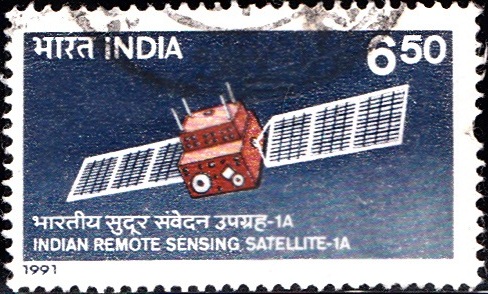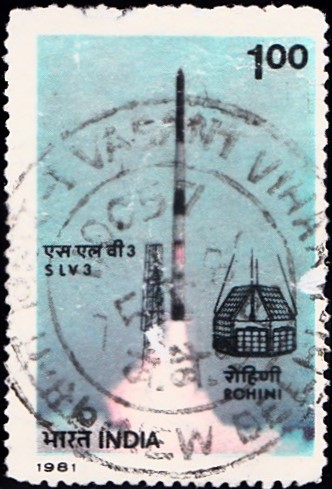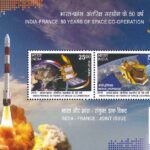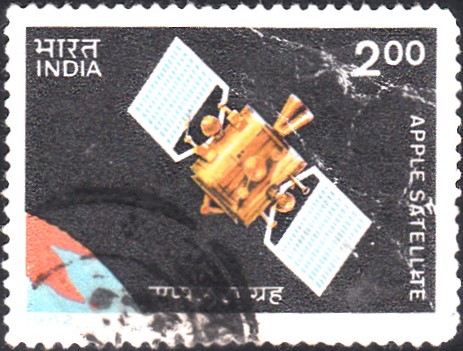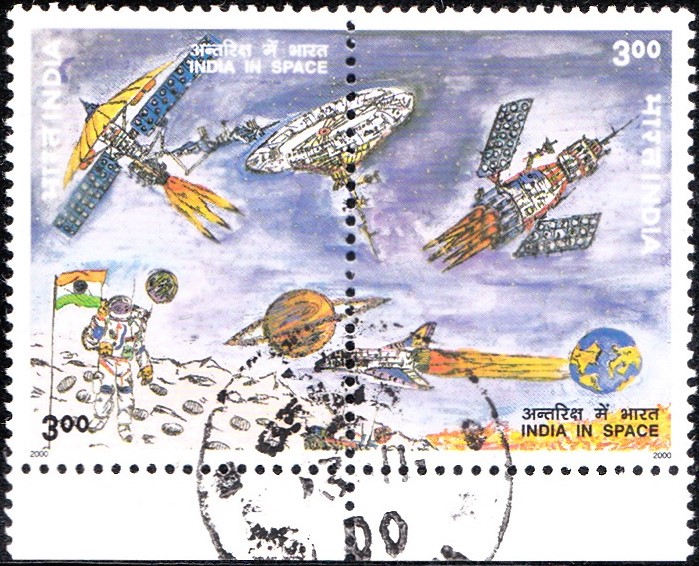
India in Space 2000
Complete Set of 4 nos of postage stamps on the Indian Space Programme :



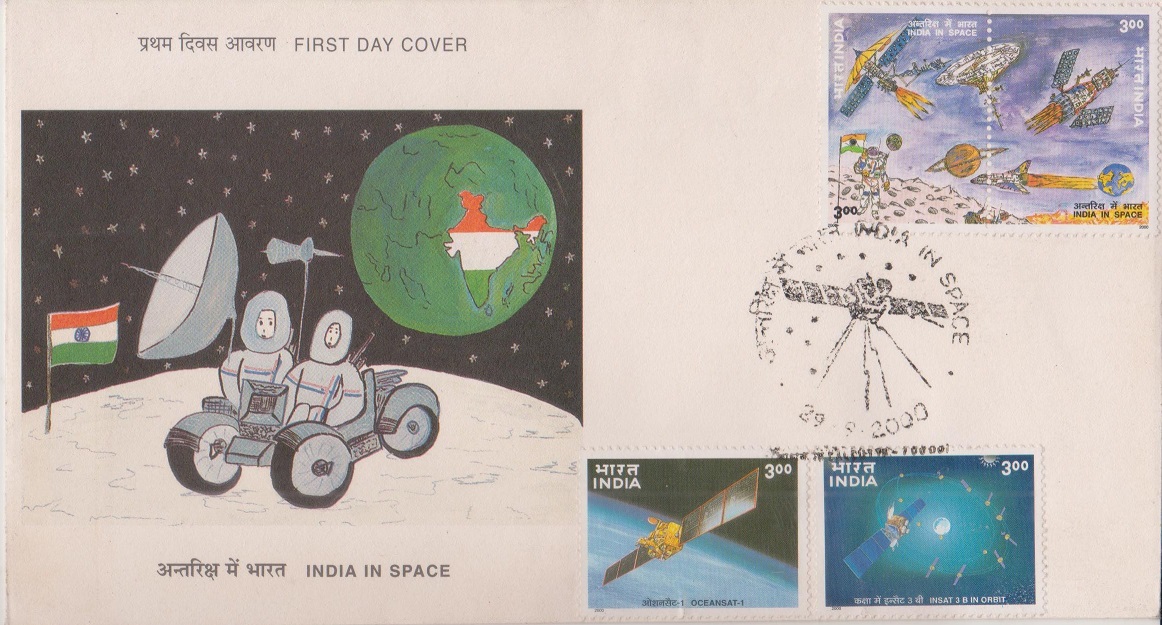 Issued by India
Issued by India
Issued on Sep 29, 2000
Stamp Designs : The first two stamps are on OCEANSAT-1 and INSAT-3B respectively, representing the country’s latest achievements in satellite technology. The third stamp in setenant format carries a painting by S. Praveen, winner of the 1st prize in the senior category in Stamp Design Competition for Children: 1999 on the theme ‘India in Space – 2025’, indicative of the fascination of the young mind for space exploration and the quest for knowledge about the unknown. It also brings out the yearning of the new generation to see India excelling in this advanced field of science.
The first day cover is yet another painting made for Stamp Design Competition for Children: 1999, by Parishi Miaish Yagnik, on the theme ‘India in Space – 2025’.
Credits :
Stamp : ISRO (OCEANSAT-1 and INSAT-3B) and S. Praveen (India in Space)
FDC : Parishi Minish Yagnik
Cancellation : Alka Sharma
Type : 2 Single Stamps and 1 Se-tenant pair of 2 Stamps, Postal Used
Colour : Four Colour
Denomination : 300, 300 & (300 + 300) Paise
Overall size : 2.9 x 3.9 cms. & 5.8 x 3.9 cms. (Setenant)
Printing Size : 2.5 x 3.55 cms. & 3.55 x 2.7 cms. (Setenant)
Perforation : 13.5 x 13.5
Paper : Matt Chromo
Stamps Printed : 3 million each
Number per issue sheet : 40
Printing Process : Photo Offset
Printer : Calcutta Security Printers Ltd.
About :
- India’s space programme was formally organised in 1972 when the Department of Space was established. The space programme, since its inception, has been guided by a vision that has emphasized the application of space technology specifically in the areas of telecommunication, television broadcasting, meteorology and resources survey and management. Development of satellites, launch vehicles and associated ground systems is essential to the space programme objective. The Indian Space Research Organisation (ISRO), National Remote Sensing Agency and Physical Research Laboratory are the agencies for executing the programme.
- Major Space SystemsIndia has established two main space systems – the Indian National Satellite (INSAT) system and Indian Remote Sensing Satellite (IRS) system, which have become important elements of national infrastructure. INSAT is one of world’s largest multipurpose domestic satellite system providing services in the area of telecommunications, television broadcasting, educational television, business communication, mobile communication, search and rescue and meteorology. There are 280 telecommunication terminals of various types including 50 terminals for rural telegraphy in the north east, operating in the INSAT network providing about 5,322 two-way speech circuits over 166 routes. A large number of satellites based networks such as Indian Telephone Industries (ITI), Oil & Natural Gas Commission and National Thermal Power Corporation are operating through INSAT. The meteorological data gathering with VHRR instrument on board INSAT and its dissemination, along with its collection of remote area meteorological data from unattended platforms, has vastly improved weather forecasting in the country. Satellite based locale-specific disaster warning system has been established with over a hundred disaster warning receivers installed in the cyclone-prone coastal areas. INSAT has enabled a vast expansion in the television service with over 800 TV transmitters linked through INSAT. The INSAT television network provides access to over 80 per cent of India’s population. The IRS system, providing space-based remote sensing data is the back-bone for several projects covering agriculture, water resources, urban development, mineral prospecting, environment and forestry, drought and flood forecasting and ocean resources.
- Launch Vehicle TechnologyLaunch vehicle development which started in a modest way through SLV-3 which could put 40 kg class Satellite into near earth orbit received a major boost through the successful flights of the Augmented Satellite Launch Vehicle (ASLV), which injected the SROSS Satellites into low earth orbits, in 1992 and 1994. With a view to make its space programme self reliant, India has subsequently developed and commissioned the Polar Satellite Launch Vehicle (PSLV) that can launch 1,200 kg class remote sensing satellites in polar sun-synchronous orbit. A Geosynchronous Satellite Launch Vehicle (GSLV), that can launch 2,000-2,500 kg class of INSAT satellites into geo-synchronous transfer orbit is in an advanced stage of development.
- Space ScienceResearch in space science is actively pursued through the Physical Research Laboratory, Ahmedabad, Space Physics Laboratory, Thiruvananthapuram, Space Applications Centre, Ahmedabad and ISRO Satellite Centre, Bangalore.
- International CooperationIndia has cooperative agreements in space with several countries and space agencies. Training in space applications is offered to personnel from developing countries under scheme known as Sharing of Experience in Space (SHARES). On the commercial front, India offers space hardware and services to international customers through Antrix Corporation of Department of Space.
- The FutureIndia’s space programme enters the new millennium with confidence, continuing to lay emphasis on large scale applications of space technology, while adapting to the dynamic and complex challenges that will emerge. Increasing and enhancing the INSAT services with incorporation of transponders in higher frequencies like KU and Ka-bands, introducing new services like direct-to-home television and digital audio broadcasting, tele-education, tele-health and personal communication, navigation and mobile communication, meteorology and disaster management and establishment of countrywide satellite based GRAMSAT system are envisaged. India will continue to retain its leadership in the field of space based remote sensing by developing and launching more advanced satellites having improved spatial and spectra resolutions, for applications in the area of agriculture, forestry, water, minerals, urban development and environment monitoring. Space science research will also be pursued to add to the world’s knowledge on our universe while providing new avenues to our scientists.
- Text : ‘India – A Reference Annual‘ (Publications Division) and material furnished by ISRO.


